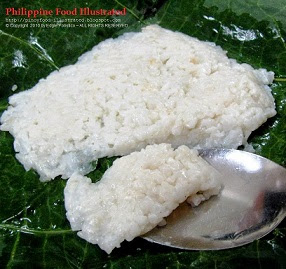Similar dishes:
- also spelled as pastel in Maguindanaon
- patel or pater in Maranao
- paster in Iranun
It is closely similar to the Tagalog binalot sa dahon except for the way how it is wrapped in banana leaf.
A scoop (about a cup) of steamed or boiled plain rice is placed on the center of a spread of banana leaf and topped with shreds or flakes of sautéed meat or fish called kagikit.
The cut of banana leaf is wilted first in fire or ember to soften and make it a pliant wrapper.
The scoop of cooked rice is then molded by folding the banana leaf. Before finally wrapping the rice, it is topped with kagikit (sautéed shredded meat) usually that of shredded meat of braised fish or chicken. Then the leaf is finally rolled around the topped rice. It is sealed by folding both ends similar to that of suman (Tagalog rice stick), only that the pastil is wider and flatter in shape than that of suman.
The special version of pastil has more meat, plus a hard-boiled chicken egg (shelled and cut into halves) as toppings, and the rice is mixed with a little amount of glutinous rice that would bind well the molded meal.
Pastil is considered the budget combo meal of our Muslim brothers in Mindanao.
In Manila, it is sold and readily available in the ubiquitous Halal restaurants and eateries near the Golden Mosque in the Quiapo district and in Maharlika Village in Taguig City.
Pastil is usually served and eaten by pouring some soy sauce right before eating and paired with hard-boiled chicken egg. It can also be eaten on the go by holding a piece of pastil and peeling it just like when you open a banana and eat it while standing, walking, or on a ride.
A mold of rice is topped with kagikit of sautéed shredded chicken meat from Cotabato City
A mold of rice is topped with kagikit of shredded fish adobo. This one is from Quiapo, Manila.
Mounds of pastil is a common sight at the many foodstands along Sinsuat Ave ext. cor Quezon Ave. in Cotabato City.
In Metro Manila, you can also buy pastil in Maharlika Market and in talipapa and eateries nearby the Blue Mosque in the Maharlika Village in Taguig City.
.JPG)
.JPG)
.JPG)
.jpg)
.JPG)
.JPG)

.JPG)
.JPG)
.JPG)







.JPG)
.JPG)
.JPG)
.JPG)
.JPG)











